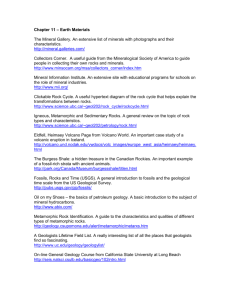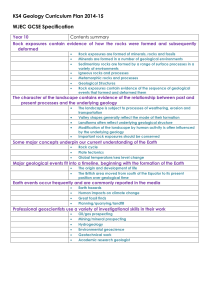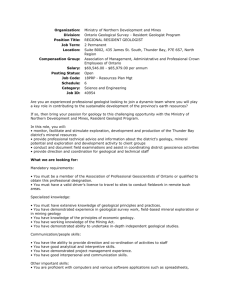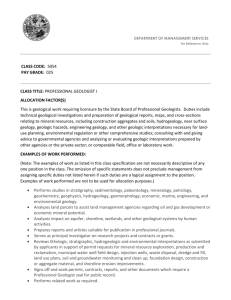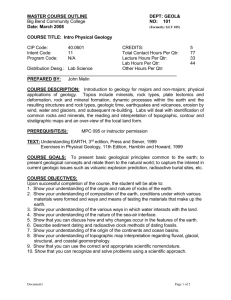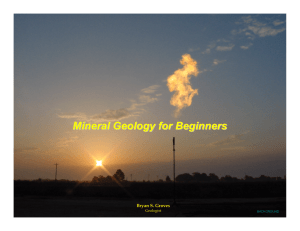Webelos_Geologist_ha..
advertisement
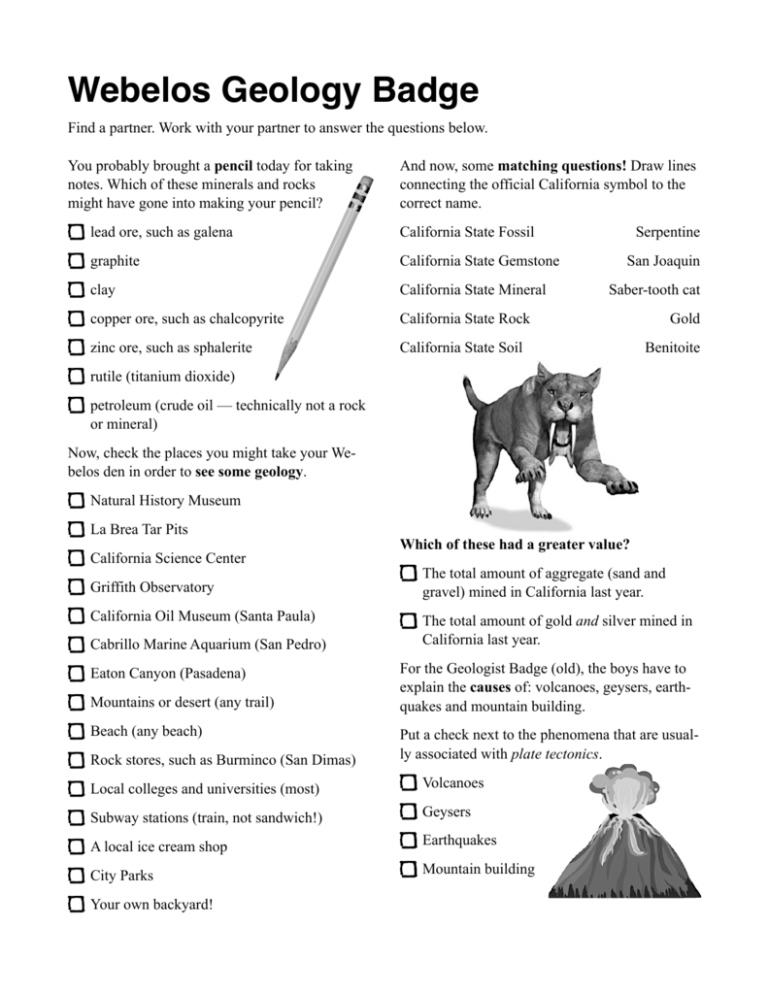
Webelos Geology Badge Find a partner. Work with your partner to answer the questions below. You probably brought a pencil today for taking notes. Which of these minerals and rocks might have gone into making your pencil? And now, some matching questions! Draw lines connecting the official California symbol to the correct name. lead ore, such as galena California State Fossil graphite California State Gemstone clay California State Mineral copper ore, such as chalcopyrite California State Rock zinc ore, such as sphalerite California State Soil Serpentine San Joaquin Saber-tooth cat Gold Benitoite rutile (titanium dioxide) petroleum (crude oil — technically not a rock or mineral) Now, check the places you might take your Webelos den in order to see some geology. Natural History Museum La Brea Tar Pits California Science Center Griffith Observatory California Oil Museum (Santa Paula) Cabrillo Marine Aquarium (San Pedro) Eaton Canyon (Pasadena) Mountains or desert (any trail) Beach (any beach) Rock stores, such as Burminco (San Dimas) Which of these had a greater value? The total amount of aggregate (sand and gravel) mined in California last year. The total amount of gold and silver mined in California last year. For the Geologist Badge (old), the boys have to explain the causes of: volcanoes, geysers, earthquakes and mountain building. Put a check next to the phenomena that are usually associated with plate tectonics. Local colleges and universities (most) Volcanoes Subway stations (train, not sandwich!) Geysers A local ice cream shop Earthquakes City Parks Mountain building Your own backyard! Resources for the Geologist Badge #1 (new #2): Collect five geologic specimens… We’re surrounded by millions of other people, and good collecting locations are gone, illegal or inaccessible. One alternative is a rock shop. Unfortunately, the very best rock shop, Burminco, has apparently gone out of business. #2 & 4 (new #6): Rock and mineral uses http://www.mii.org/commonminerals.html http://www.rocksforkids.com/RFK/uses.html What is cement — http://www.buildeazy.com/newplans/eazylist/ cement.html #3 (new #4): Mineral hardness scale http://www.sdnhm.org/archive/kids/minerals/howto-hardness.html http://chemistry.about.com/od/geochemistry/a/mohsscale.htm Also, you can buy a hardness scale from educational supply shops online. #5: Cause of a volcano, a geyser, or an earthquake http://volcano.oregonstate.edu/ Volcanoes are cool, and this is the “Volcano World” web site. http://www.enchantedlearning.com/subjects/volcano/activities.shtml Some parts of this web site require a subscription to access. http://volcanoes.usgs.gov/about/edu/dynamicplanet/ Good information about volcanoes and plate tectonics Natural History Museum of Los Angeles County — http:// www.nhm.org/site/ Cabrillo Marine Aquarium — http://www.cabrillomarine aquarium.org/ California Science Center. See the earthquake exhibit on the second floor — http://www.californiasciencecenter.org/ Jurupa Mountains Discovery Center, Riverside — http://jmdc.org/ scoutswebelos/ Vasquez Rocks County Park — they have a geology trail, and lots of rocks to climb and trails to hike. BL#1 (new #1): Define geology http://geology.com/articles/what-is-geology.shtml BL#2 (new #3): Collect rocks Rocks can be found all over, including in your own backyard! Some of my favorite places to take scouts for rock collecting are: Angeles National Forest — http://www.fs.usda.gov/angeles Eaton Canyon — http://www.ecnca.org/ Forrestal Nature Reserve — http://www.pvplc.org/_lands/forrestal.asp (No fossil collecting) BL3: The difference between a rock and a mineral http://www.rocksandminerals.com/rockcycle.htm New #5 & 7: Map of your state & some geological features http://earthquake.usgs.gov/ Earthquakes are a little scary, but this web site has the latest information. http://www.conservation.ca.gov/cgs/information/geologic_mapping/Pages/index.aspx #6: How are mountains formed? http://www.sanandreasfault.org/Maps.html http://www.universetoday.com/29833/how-mountains-are-formed/ http://geology.about.com/od/geology_ca/a/aaCA_geotourism.htm http://en.wikipedia.org/wiki/Mountain General web sites: #7: Fossils http://meritbadge.org/wiki/index.php/Geologist This web site has links to many more web sites, including worksheets and general resources. In most places, fossil collecting is not legal. And it’s often difficult, which can be frustrating for young boys. The Natural History Museum sometimes leads fossil collecting tours of Silverado Canyon, in Orange County — http://www. nhm.org/ A great place to see fossils is La Brea Tar Pits — http://www. tarpits.org/ At Cabrillo Beach you can see fossils in the rocks, and Cabrillo Aquarium has fossils on display — http://www.cabrillo marineaquarium.org/ #8 (new #2): field trip to a geological site… There are many places that qualify as a “geological site”. Here are just a few: Page Museum at La Brea Tar Pits — http://www.tarpits.org/ (The Page Museum made Smithsonian.com’s list of the top ten geological sites in the country!) http://www.consrv.ca.gov/cgs/geotour/Pages/Index.aspx http://meritbadge.org/wiki/images/b/b0/Geologist.pdf A three page workbook (with links) for the geologist badge. http://www.cubroundtable.com/assets/pdf-documents/GeologistActivity-Badge-Outline.pdf Another workbook — this one’s 17 pages long. http://www.conservation.ca.gov/cgs/Pages/Index.aspx The California Geological Survey http://geology.com/articles/san-andreas-fault.shtml The San Andreas fault What else? You are encouraged to send me an e-mail if you have questions: Randy Adsit, adjunct professor of geology, East L.A. College, <radsit@mac.com>. ANSWERS: Pencil minerals = all except lead ore (pencil lead is made of graphite and clay). Places to see geology = all of them! Matching: Fossil = saber tooth cat; gemstone = benitoite; mineral = gold; rock = serpentine (serpentinite); soil = san joaquin soil series. Greater value = aggregate. Phenomena associated with plate tectonics = all of them.


